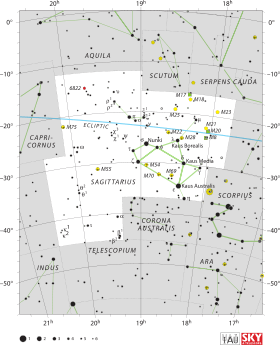Phi Sagittarii
Phi Sagittarii (Phi Sgr, φ Sagittarii, φ Sgr) is a star in the southern constellation of Sagittarius. With an apparent visual magnitude of 3.17,[2] it is the ninth-brightest star in the constellation and is readily visible to the naked eye. Parallax measurements place it at a distance of roughly 239 light-years (73 parsecs) from the Earth.[1]
 | |
| Observation data Epoch J2000 Equinox J2000 | |
|---|---|
| Constellation | Sagittarius |
| Right ascension | 18h 45m 39.38610s[1] |
| Declination | –26° 59′ 26.7944″[1] |
| Apparent magnitude (V) | 3.17[2] |
| Characteristics | |
| Spectral type | B8.5 III[3] to B7 IV[4] |
| U−B color index | –0.36[5] |
| B−V color index | –0.11[5] |
| Astrometry | |
| Radial velocity (Rv) | +21.5[2] km/s |
| Proper motion (μ) | RA: +50.61[1] mas/yr Dec.: +1.22[1] mas/yr |
| Parallax (π) | 13.63 ± 0.19[1] mas |
| Distance | 239 ± 3 ly (73 ± 1 pc) |
| Absolute magnitude (MV) | −1.16[6] |
| Details | |
| Mass | 4–4.2[7] M☉ |
| Radius | 4.8[7] R☉ |
| Luminosity | 475[7] L☉ |
| Temperature | 14,990[4] K |
| Rotational velocity (v sin i) | 35[8] km/s |
| Age | 165[7] Myr |
| Other designations | |
| Database references | |
| SIMBAD | data |
The stellar classification of this star has been rated at B8.5 III[3] and B7 IV,[4] with a luminosity class of III indicating it is a giant star, while a class of IV suggests it is still a subgiant star. Both represent stages in the evolution of a star after it has exhausted the hydrogen at its core. This energy is being radiated from the star's outer envelope at an effective temperature of 14,990 K,[4] which produces the blue-white hue typical of B-type stars.[10]
In the past, this star catalogued as a spectroscopic binary and a companion was apparently detected through lunar occultation.[11] However, it is most likely a solitary star[7][12] and any nearby stars are merely optical companions.
Name and etymology
In the catalogue of stars in the Calendarium of Al Achsasi al Mouakket, this star was designated Aoul al Sadirah, which was translated into Latin as Prima τού al Sadirah, meaning first returning ostrich.[13]
In Chinese, 斗 (Dǒu), meaning Dipper, refers to an asterism consisting of φ Sagittarii, λ Sagittarii, μ Sagittarii, σ Sagittarii, τ Sagittarii and ζ Sagittarii. Consequently,the Chinese name for φ Sagittarii itself is 斗宿一 (Dǒu Sù yī, English: the First Star of Dipper.)[14]
This star, together with γ Sgr, δ Sgr, ε Sgr, ζ Sgr, λ Sgr, σ Sgr and τ Sgr comprising the Teapot asterism.[15] φ Sgr, σ Sgr, ζ Sgr, χ Sgr and τ Sgr were Al Naʽām al Ṣādirah (النعم السادرة), the Returning Ostriches.[16] According to the catalogue of stars in the Technical Memorandum 33-507 - A Reduced Star Catalog Containing 537 Named Stars, Al Naʽām al Ṣādirah or Namalsadirah was originally the title for four stars: φ Sgr as Namalsadirah I, τ Sgr as Namalsadirah II, χ1 Sgr as Namalsadirah III and χ2 Sgr as Namalsadirah IV (except σ Sgr and ζ Sgr) .[17]
References
- van Leeuwen, F. (November 2007), "Validation of the new Hipparcos reduction", Astronomy and Astrophysics, 474 (2): 653–664, arXiv:0708.1752, Bibcode:2007A&A...474..653V, doi:10.1051/0004-6361:20078357
- Wielen, R.; et al. (1999), "Sixth Catalogue of Fundamental Stars (FK6). Part I. Basic fundamental stars with direct solutions", Veroeffentlichungen des Astronomischen Rechen-Instituts Heidelberg, Astronomisches Rechen-Institut Heidelberg, 35 (35): 1, Bibcode:1999VeARI..35....1W
- Houk, Nancy (1979), Michigan catalogue of two-dimensional spectral types for the HD stars, 3, Ann Arbor, Michigan: Dept. of Astronomy, University of Michigan, Bibcode:1982mcts.book.....H
- Zorec, J.; et al. (July 2009), "Fundamental parameters of B supergiants from the BCD system. I. Calibration of the (λ_1, D) parameters into Teff", Astronomy and Astrophysics, 501 (1): 297–320, arXiv:0903.5134, Bibcode:2009A&A...501..297Z, doi:10.1051/0004-6361/200811147
- Johnson, H. L.; et al. (1966), "UBVRIJKL photometry of the bright stars", Communications of the Lunar and Planetary Laboratory, 4 (99): 99, Bibcode:1966CoLPL...4...99J
- Anderson, E.; Francis, Ch. (2012), "XHIP: An extended hipparcos compilation", Astronomy Letters, 38 (5): 331, arXiv:1108.4971, Bibcode:2012AstL...38..331A, doi:10.1134/S1063773712050015.
- Kaler, James B., "PHI SGR (Phi Sagittarii)", Stars, University of Illinois, retrieved 2012-01-15
- Abt, Helmut A.; Levato, Hugo; Grosso, Monica (July 2002), "Rotational Velocities of B Stars", The Astrophysical Journal, 573 (1): 359–365, Bibcode:2002ApJ...573..359A, doi:10.1086/340590
- "phi Sgr -- Star", SIMBAD, Centre de Données astronomiques de Strasbourg, retrieved 2012-01-15
- "The Colour of Stars", Australia Telescope, Outreach and Education, Commonwealth Scientific and Industrial Research Organisation, December 21, 2004, archived from the original on March 10, 2012, retrieved 2012-01-16
- Finsen, W. S. (April 1951), "The duplicity of phi Sgr", Astronomical Journal, 56: 56, Bibcode:1951AJ.....56Q..56F, doi:10.1086/106589
- Eggleton, P. P.; Tokovinin, A. A. (September 2008), "A catalogue of multiplicity among bright stellar systems", Monthly Notices of the Royal Astronomical Society, 389 (2): 869–879, arXiv:0806.2878, Bibcode:2008MNRAS.389..869E, doi:10.1111/j.1365-2966.2008.13596.x
- Knobel, E. B. (June 1895), "Al Achsasi Al Mouakket, on a catalogue of stars in the Calendarium of Mohammad Al Achsasi Al Mouakket", Monthly Notices of the Royal Astronomical Society, 55: 430, Bibcode:1895MNRAS..55..429K, doi:10.1093/mnras/55.8.429.
- (in Chinese) AEEA (Activities of Exhibition and Education in Astronomy) 天文教育資訊網 2006 年 5 月 11 日
- Teapot, constellation-guide.com, retrieved 2017-05-13.
- Allen, R. H. (1963), Star Names: Their Lore and Meaning (Reprint ed.), New York: Dover Publications Inc, p. 355, ISBN 0-486-21079-0, retrieved 2012-09-04.
- Rhoads, Jack W. (November 15, 1971), Technical Memorandum 33-507-A Reduced Star Catalog Containing 537 Named Stars (PDF), Jet Propulsion Laboratory, California Institute of Technology.